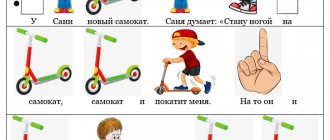A child begins to pronounce whistling sounds correctly at about 3-4 years of age. But some children have problems with articulation. If measures are not taken promptly, speech dysfunction will persist for life. To create whistling sounds, a set of special exercises is usually prescribed. They are performed both in classes with a speech therapist and at home.
The importance of making a whistling sound
Speech defects that develop in childhood can lead to communication difficulties in adulthood. Therefore, the production of whistling sounds must be carried out in a timely manner. The earlier a deviation is detected, the greater the chances of its successful elimination. Typically, defects become noticeable when the child enters the middle group of kindergarten. Speech therapists distinguish two types of disorders:
- parasigmatism;
- sigmatism.
With sigmatism, the child’s pronunciation of the sound “s” in soft and hard forms is distorted. With parasigmatism, its replacement occurs. Deviations in spoken language can have a negative impact on the functioning of the nervous system. This subsequently leads to low self-esteem and communication disorders. Against the background of incorrect pronunciation, the following develops:
- Dyslalia is a disease characterized by difficulty pronouncing certain sounds.
- Dysgraphia is a deviation accompanied by the replacement and rearrangement of letters during writing.
- Dyslexia is a reading problem caused by the inability to combine letters into a single text.
Preparatory activities
Before performing exercises aimed at developing conversational speech, breathing training is carried out. She teaches how to blow a stream of air from the lungs. To make the training more interesting for the child, it is recommended to use a small cotton wool or ball.
The most common exercises that develop breathing include the following tasks:
- It is necessary to prepare an empty small bottle. Its neck should be brought to the lower lip. A stream of air is directed into the bubble. If the baby does everything correctly, a characteristic sound appears. This exercise is called “storm”.
- The palms need to be placed on the stomach. Then a deep breath is taken through the nose, after which the breath is held for a couple of seconds. Exit is through the mouth. The purpose of the exercise is to teach the child to control the air stream. The task is called "accordion".
- The “breeze” exercise is performed by stretching out the lips with a tube. A deep breath is taken through the nose. Then a palm is placed to the lips, and a stream of air is released through the mouth.
How to set sound mechanically
Speech development can also be carried out mechanically. In this situation, it is recommended to actively use special simple exercises:
- “Depict” a wide smile on your face, with your tongue in an interdental position. An important condition is not to touch the upper row of teeth. After some time, the mouth muscles relax, then the exercise is repeated again.
- The next step is to blow on the tip of the tongue, which should be protruding from the oral cavity. To feel the air stream, you should place your palm to your lips.
- While the child is blowing air, you need to press on the tongue with a toothpick. This will help form a groove through which the air stream is directed.
- At the next stage, the jaws close, but the toothpick remains between them. It helps fix the tongue in the desired position. The passage of an air stream will cause a whistle.
- While playing the whistling sound, you need to press a toothpick on different parts of the tongue, identifying in which position the “s” will sound correctly.
- After the child manages to pronounce the desired sound, the exercise is performed without using a toothpick.
Correct articulation of sounds
For correct articulation and automation of the pronunciation of whistling phonemes, the speech organs must take the following positions:
| Sound | Correct position |
| [WITH] | The lips smile, the tip of the tongue is on the lower palate, resting on the teeth. When pronouncing a sound, the back of the tongue rises, forming a slide. A gap is formed between the teeth, the air stream flows freely and strongly along the back of the tongue. Sound is formed without voice. |
| [Sya] | The smile will be a little larger, the tongue with a straight back is fixed above the lower palate, in the middle, the tense tip rests on the lower jaw. The air comes in a sharp stream. |
| [Z] | Formed like [C], but with a voice. |
| [Z] | It is produced according to the principle of articulation [Сь], but there is vibration of the ligaments. |
| [Ts] | The lips smile, the tip of the tongue rests on the lower jaw, the back is curved, so there is a stop between the alveoli and the body of the tongue. An abrupt air stream is applied, the closed link is broken, and the voice almost does not participate in the formation of the phoneme. |
Staging from other sounds
The correct pronunciation of “s” can be formed from other sounds. In this case we will talk about the sounds “ts” and “sh”. Initially, the child should reproduce “sh” in a drawn-out manner. Then the tongue gradually moves towards the teeth, without leaving the palate. "Sh" will gradually transform into a fuzzy whistling sound. To get a “s” out of it, you need to clench your teeth. After this, the child must repeat the attempt to replace one sound with another.
The production of whistling consonant sounds from “ts” is less common. The essence of the method is the drawn-out pronunciation of the sound “ts”. The child will not have to change the position of the tongue. The sound is automatically transformed into “s”. After this, it is recommended to consolidate the result with the help of tongue twisters or poems.
What problems does incorrect sound pronunciation cause?
Good diction depends on the quality of the sounds pronounced. There are no main ones among them. The absence of at least one of them leads to speech distortion. If speech errors are not corrected in time, this can cause serious speech impairments. And they lead to the following pronunciation deficiencies in students:
- There are errors in the spelling of words. Replace letters or skip them. Writing literacy is declining.
- Reading is very difficult. Children do not understand what they read. They cannot answer questions about the text they read.
- They perceive information poorly by ear.
- There is a distortion of whistling sounds - sigmatism. In this case, S, C resemble F. Z is similar to V. Also, what is heard is not a whistle, but a noise (T or D), or hissing. These problems arose due to an incorrectly formed speech pattern of sound phonemes. Their transformation occurs through the production of sounds by a specialist.
- Replaced by whistling sounds - parasigmatism. This is based on a phonemic defect. The technology for correcting parasigmatism is based on the development of phonemic hearing. Establishing the correct articulatory pattern of whistlers, automating them in speech are issues that in this case should only be dealt with by a specialist.
What methods exist for sigmatism
The production of the sounds “s”, “z” and “ts” with sigmatism is carried out in several ways. They are selected based on the nature of the deviation. Sigmatism is a distortion of the pronunciation of the sound “s”. The nature of the origin of the pathology is determined in the speech therapist's office. Possible causes of sigmatism include:
- neuritis;
- perceptual deviations;
- improper development of the maxillofacial apparatus;
- recently lost baby teeth;
- disturbances in figurative thinking.
Most often, sound pronunciation is corrected with the help of exercises, but in some cases a mechanical method may be required. The set of articulation exercises will vary in each individual case.
Interdental sigmatism
The deviation is characterized by the incorrect placement of the tongue between the teeth. It rests against the edges of the upper or lower incisors, which creates an obstacle to the passage of the air stream. “C” in this case changes to “t”. The main reason for this violation is considered to be the incorrect structure of the conversation between parents and the child. The likelihood of interdental sound is reduced with the necessary interaction between the baby and adults.
To correctly pronounce whistling sounds, they resort to imitation. In this case, the child tries to repeat after the adult. If this method does not produce results, installation is carried out mechanically.
Lateral sigmatism
Speech impairment with lateral sigmatism is accompanied by insufficient activity of the muscle tissue on the sides of the tongue. When trying to pronounce sounds, the tip of the organ rests on the area of the alveoli. Speech becomes completely unclear. A set of special exercises helps to improve sound pronunciation. Among the most effective are:
- alternate inflation and retraction of the cheeks;
- maximum opening and closing of the jaw, provided that the tongue is located at the bottom of the mouth;
- prolonged imitation of chewing with the mouth closed;
- rotation of the tongue in the predental area with the oral cavity slightly open;
- suction of an air stream through a tube made from the tongue.
Nasal sigmatism
Nasal sigmatism develops as a result of incomplete closure of the posterior wall of the pharynx with the soft upper palate. This happens when there is damage to the nervous system or when there are clefts in the palate. An exercise that involves blowing out the sound “f” helps to cope with this form of deviation. The child should place the wide part of the tongue between the lower lip and the upper incisors. From this position the sound “f” is pronounced. In the meantime, the tongue should be gradually retracted behind the teeth.
Dental parasigmatism
One of the causes of parasigmatism is malocclusion of the teeth. In this case, speech therapy exercises are used to produce speech. The emphasis is on the baby's tactile sensations and the correct location of the articulation organs. Initially, a soft “s” is set. Breathing work is being done. For these purposes, the child puts his hand to his mouth and directs the air flow onto it, after taking a deep breath. If he manages to pronounce “s”, there is no need to complete the lessons. It is necessary to consolidate the result by periodically repeating the exercises.
Pronunciation of sounds С, Сь, З, Зь, Ц at home
In order for your child to please you with the correct pronunciation of problematic sounds, you need to work with him at home. The process of making whistling sounds in a child consists of three main stages:
- Articulation gymnastics. It includes exercises that prepare certain movements of the articulatory apparatus, the position of the tongue and lips necessary for the pronunciation of whistling sounds. Therefore, a set of exercises should not be random.
- Sound production. In order for a preschooler to be able to control the articulatory apparatus, he must know what position his lips, teeth, and tongue occupy at the moment of pronouncing a sound. The child initially receives this information in the form of a fairy tale, and subsequently consolidates it in practice with the help of an adult.
- Sound fixation. For this there is a wide range of possibilities: from pronunciation of a chain of sounds, syllables, words to fairy tales using the necessary sounds “s”, “s”, “z”, “z”, “ts”.
Testing a child’s ability to distinguish the sounds S, Z, C
Before you start working with your baby, you need to check how well he can handle the differentiation of whistling sounds. To do this, you can use the following task.
Offer to repeat after you the words: “airplane-badger-coconut”, “blue-geese-moose”; “hare-goat-watermelon”, “winter-newspaper-star”; "heron-egg-cucumber".
It’s easy to create such collections yourself. Listen closely to how your child pronounces words and the problematic sound will stand out.
Articulation gymnastics for whistling sounds
- "Smile". Invite your child to smile widely without showing his teeth.
- "The hippopotamus yawns." The baby opens his mouth wide and wide.
- "The snake is teasing." Stick out the snake (sharp tongue) and hide it between tightly compressed lips.
- "Tick-tock." We stick out the tongue and move it left and right.
- "Angry Kitten" The preschooler smiles with his mouth open. The tip of the tongue rests on the lower teeth and alternately curves and then relaxes.
- "Tube". Suggest making a tube from the tongue: stick it out, bending the side edges up. Let the child try to blow into the resulting “tube”.
The block includes 2-3 exercises. Each is completed within 5 seconds. It is possible to alternate exercises. The recommended total warm-up time is 5-10 minutes. It is advisable to do it daily.
Establishing correct articulation
In order to develop correct articulation in a child, adults need to know its features, which are as follows:
- The teeth are closed, but there is no need to squeeze them. Let a natural millimeter gap remain.
- The lips smile and tune in to the vowel sound that follows the whistling sound.
- The tip of the tongue rests on the lower teeth, its back (middle part) is curved.
- The lateral edges of the tongue are pressed against the upper molars.
- The soft palate is pressed tightly against the back wall of the pharynx, air does not escape into the nose.
This articulation applies to all whistlers. The difference is that pronouncing Сь requires more strain on the tongue than with hard S. The sounds З, Зь are pronounced in the same position of the articulatory apparatus, but with the voice connected.
Gymnastics and articulation organs should be performed in front of a mirror. The child watches as the adult shows him, and then repeats it several times, watching himself in the mirror.
A set of articulation exercises
Differentiation of whistling patients is based on the performance of exercises that the speech therapist selects individually. Among the most effective are the following:
- It is necessary to open your mouth wide in a smile without closing your teeth. After a few seconds, you can relax your lip muscles. The exercise is repeated 5-6 times.
- The starting position is the same as in the previous exercise. You need to run the tip of your tongue along the gums, simulating brushing. First, attention is paid to the upper teeth, then to the lower teeth.
- The mouth stretches into a smile, after which the tip of the tongue should touch the corners of the lips one by one. The chin should be motionless at this moment.
- The tongue protrudes as much as possible. First, it must be pulled to the tip of the nose, and then to the chin. After this, you should alternately touch the wide side of your tongue to your lips.
- With your teeth completely closed, you should stretch your lips into a tube as much as possible. The exercise is repeated 5 times.
Hissing sounds: where to start staging
We show the child a card with the sound Ш, draw a phoneme, explain how the tongue is located: now it is at the top, the edges are pressed tightly against the molars. Instead of the phrase “sound Ш” it is better to say “warm wind”, “snake hisses”, “inflate the balloon”.
Articulatory gymnastics for staging hissing (exercises by L.A. Komarova)
- “Cup”
- the mouth is open. Raise a wide, relaxed tongue to the upper lip. Bend the middle part of the tongue and bend the side edges upward. It turns out to be a cup. We take the “cup” inside and take it back out. Do this several times. - “Horse”
- “glue” the tongue to the palate. Thus, the hyoid frenulum is stretched. The lower jaw remains motionless. With a click, we “unstick” the tongue - the “horse” clicks. - “Fungus”
- “glue” the tongue to the palate, open the mouth wide. Hold this position for several seconds. - “Accordion”
- make a “mushroom”. Only now we open and close our mouth, stretching the hyoid frenulum. Keep your tongue “glued” to the palate, lips in a smile. - “Swing”
- mouth wide open. Stretch your tongue either to your nose or to your chin. - “Donut”
– mouth slightly open, lips extended slightly forward and rounded.
“Let’s warm our palms” - imagine that your hands are frozen in the cold. Open your mouth, stretch your lips forward, exhale “x-x-x”, warming your palms.
The exercises that are performed when setting C, “Punish a naughty tongue”, “Spatula”, “Candy”, “Jam”, “Brushing teeth” are repeated when setting Sh. You don’t need to do everything, choose 5-7 of any articulation exercises, and also remember about the development of the air stream.
Ways to make the sound Ш
In front of the mirror, we ask the baby to blow a cold wind onto his palm. Now invite the child to “cup” his tongue by the upper teeth onto the alveoli and try to say “ssss” again. In this position of the tongue you will hear “sh-sh-sh”. If it doesn’t work out, you can hold the roll stick between your teeth (your tongue should lie on the stick, not under it) and blow. Or use a clean finger to hold your tongue up. It is important to explain to the baby that the wide tongue should be behind the upper teeth - then “the snake will hiss.”
After successful consolidation of Ш, we obtain the sound Ж in the same way as the phoneme Z. We place our palm on the throat and ask the child to compare hissing and buzzing: “sh-sh-sh” - the throat is calm, “zh-zh” - the throat is trembling.
To get H, ask your baby to say a soft "t'-t'-t'" and gently move his tongue slightly deeper into the mouth using a spoon/q-tip/clean finger. The sound SH should appear automatically. We fix each phoneme according to the scheme, teach the child not to confuse whistling and hissing. For this purpose, learning poems where both types of sounds are found, and games for differentiating phonemes are suitable.
10 books for automating sounds
- “Speech therapist lessons. Correction of speech disorders”, N.S. Zhukova.
- “Album of a preschooler. Automation of sounds in game exercises”, L.A. Komarova.
- “We learn sounds. Home speech therapy notebook for children 5-7 years old,” E.A. Azova, O.O. Chernova.
- “We pronounce the sounds correctly. Speech therapy album for children 4-8 years old,” T.A. Tkachenko.
- “Home notebook for speech therapy sessions with children”, Yu.B. Zhikhareva-Norkina.
- “Games with paired cards. Speech therapy board games for children 5-7 years old”, Z.T. Bobyleva.
- “I speak correctly”, didactic material by O.E. Thunderous.
- “We are speaking correctly. Games for speech development”, E.M. Kuritsyna, L.A. Taraeva.
- “Album for automating sound pronunciation”, O.I. Lazarenko.
- “Speech therapy album. We speak correctly,” T.S. Reznichenko, O.D. Larina
How to consolidate the results of classes
To achieve the desired result, you should work with a speech therapist on an ongoing basis. It is strongly recommended not to quit classes at the first improvement in pronunciation. Sound fixation is carried out through automation. This process involves the use of individual sounds when pronouncing syllables, phrases and sentences. During classes with a speech therapist, you are given tasks that help improve your speaking skills. The automation stage is considered the most difficult. Activities help develop speaking skills and introduce learned sounds into everyday speech. The main task of parents is to facilitate the process by prompting and helping the child.
The most effective way to consolidate results is to read aloud. At the initial stages, you can pronounce simple tongue twisters. In the future, you need to move on to more voluminous texts. It is important to maintain a conversation with your baby. This not only trains speech, but also develops hearing.
For dysarthria in children, physiotherapy, drug treatment and speech therapy massage are used in combination with exercises. Dysarthria develops in 3-6% of cases. It is accompanied by increased tone and excessive tension in the muscles of the articulatory organs. A specific feature of the disease is the difficulty of overcoming defects. Therefore, the process of speech restoration takes much more time.
General recommendations
To get rid of sigmatism through the use of articulatory gymnastics for the sounds [З], [С], [Ц] you need to follow simple rules:
- Start your exercises with a warm-up. Slap your tongue, stretch your lips, cheeks.
- Start with easy exercises and end with difficult ones.
- Use funny poems and memorize texts with your children.
- Help your tongue take the desired position with your fingers, a pencil, or a spatula.
- Do articulation exercises in front of a mirror.
Note to parents
The sounds “ts”, “s”, “sh” can be made at home. In this case, responsibility for the outcome of the training falls on the shoulders of the parents. The following principles must be kept in mind:
- The load on the speech apparatus increases gradually. Otherwise, the baby will not be able to learn new information.
- During the exercises, it is recommended to make associations with the world of animals and insects. The sounds “s” and “z” are compared to the squeaking of a mosquito.
- It is necessary to allow the child to independently find a comfortable position for the organs of articulation to reproduce insulating sounds.
- If your child does the exercises without enthusiasm, it is better to stop exercising. This indicates that he is tired.
- Classes must be regular. The optimal frequency is 2-3 times a week. The duration depends on the nature of the baby’s speech deviation.
- When performing mechanical production of sound pronunciation, objects that are not dangerous to the child should be used. It is desirable that this be a special speech therapy probe.










